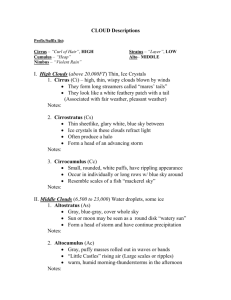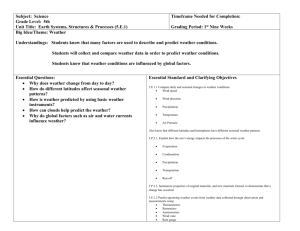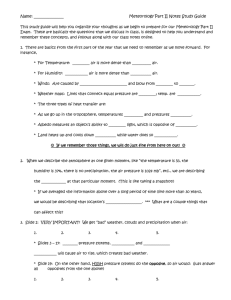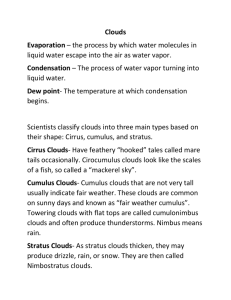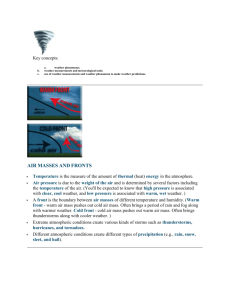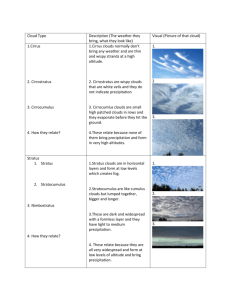Name: Meteorology Part II Notes Study Guide This study guide will
advertisement
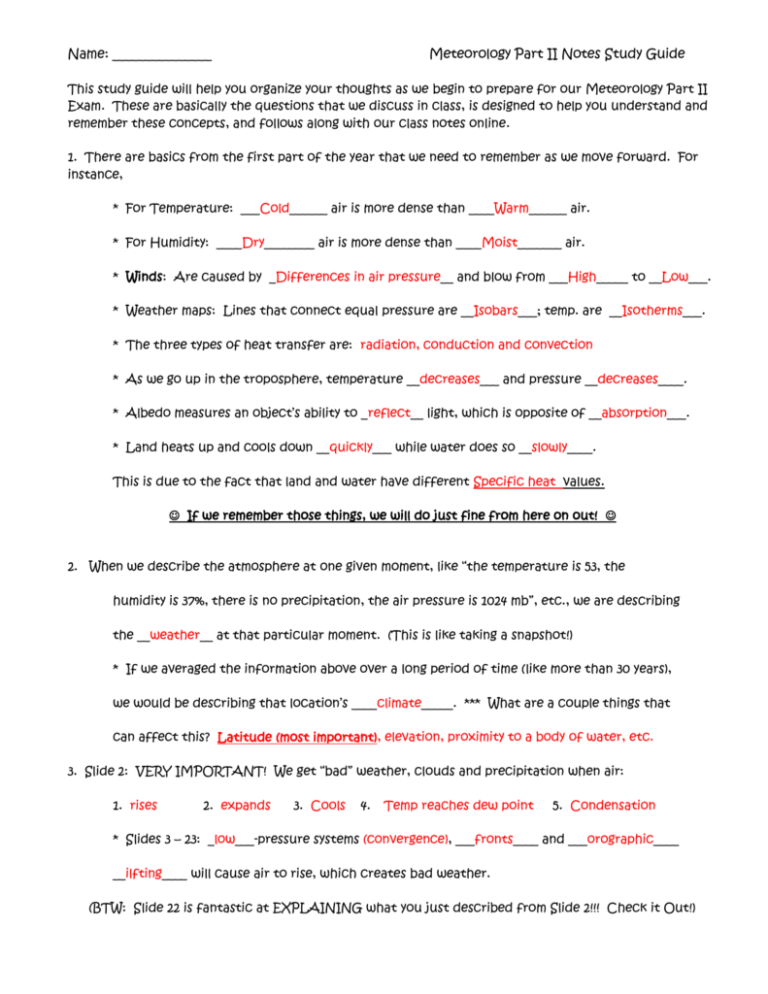
Name: _______________ Meteorology Part II Notes Study Guide This study guide will help you organize your thoughts as we begin to prepare for our Meteorology Part II Exam. These are basically the questions that we discuss in class, is designed to help you understand and remember these concepts, and follows along with our class notes online. 1. There are basics from the first part of the year that we need to remember as we move forward. For instance, * For Temperature: ___Cold______ air is more dense than ____Warm______ air. * For Humidity: ____Dry________ air is more dense than ____Moist_______ air. * Winds: Are caused by _Differences in air pressure__ and blow from ___High_____ to __Low___. * Weather maps: Lines that connect equal pressure are __Isobars___; temp. are __Isotherms___. * The three types of heat transfer are: radiation, conduction and convection * As we go up in the troposphere, temperature __decreases___ and pressure __decreases____. * Albedo measures an object’s ability to _reflect__ light, which is opposite of __absorption___. * Land heats up and cools down __quickly___ while water does so __slowly____. This is due to the fact that land and water have different Specific heat values. If we remember those things, we will do just fine from here on out! 2. When we describe the atmosphere at one given moment, like “the temperature is 53, the humidity is 37%, there is no precipitation, the air pressure is 1024 mb”, etc., we are describing the __weather__ at that particular moment. (This is like taking a snapshot!) * If we averaged the information above over a long period of time (like more than 30 years), we would be describing that location’s ____climate_____. *** What are a couple things that can affect this? Latitude (most important), elevation, proximity to a body of water, etc. 3. Slide 2: VERY IMPORTANT! We get “bad” weather, clouds and precipitation when air: 1. rises 2. expands 3. Cools 4. Temp reaches dew point 5. Condensation * Slides 3 – 23: _low___-pressure systems (convergence), ___fronts____ and ___orographic____ __ilfting____ will cause air to rise, which creates bad weather. (BTW: Slide 22 is fantastic at EXPLAINING what you just described from Slide 2!!! Check it Out!) * Slide 24: On the other hand, HIGH pressure systems do the opposite, so air would: (just answer all opposites from the one above!) 1. sink 2. contract 3. warm 4. Temp gets farther from dew pt. 5. No condensation Slides 28-31: What are the three things we need to make a cloud? (in a bottle OR the atmosphere) 1. water vapor 2. Condensation nuclei 3. air cooling to the dew point Slide 29: On the outside of this cup, the air is losing kinetic energy making it cooler. * If it loses enough energy, the ___temp_____ of the air will reach the ___dew point____ and water vapor from the air will ___condense____ on the outside of the cup. (It’ll “sweat”). * This all happened because _cold_ air can’t hold as much moisture as _warm__ air. Slides 27 – 42: Now that we have made all that condensation, we can look at the clouds that form! *Look outside RIGHT NOW!!! What type of cloud do you see? Explain what it looks like. I don’t know, because I was not with you when you completed this study guide. * Cirrus: Describe how you are going to remember how cirrus clouds look. Wispy, mare’s tails, for me. * Where do they form in the sky? And what temperatures must be present for them to form? High altitudes – lower than 32 F, 0 C or 273 K * Stratus: Describe how you are going to remember how stratus clouds look. layered clouds, low, and thick that often cover the whole sky. * Where do they form in the sky? And what temperatures must be present for them to form? Lower altitudes – higher than 32 F, 0 C or 273 K * Cumulus: Describe how you are going to remember how cumulus clouds look. Fluffy cotton balls for me * Where do they form in the sky? And what temperatures must be present for them to form? Lower altitudes – higher than 32 F, 0 C or 273 K Rain Clouds: What do we call cumulus clouds that produce precipitation? cumulonimbus What do we call stratus clouds that produce precipitation? nimbostratus What do we call cirrus clouds that produce precipitation? (be careful!) cirrus clouds don’t produce surface precipitation. Now let’s make sure we get it. * Why would we expect “bad” weather near the low-pressure systems? Rising air * We would expect “__fair/clear__” weather near high-pressure systems because air is _sinking___. * Where on a weather map would we expect strong surface winds? And why would we choose that location? Where isobars are close together – strongest gradient (greatest diff. in air pressure) * Looking at a weather map, where do we “look” to predict tomorrow’s weather patterns that will affect us over the next couple days? Toward the west – Jet stream will bring the weather patterns toward the east, since it is a prevailing westerly. The global wind known as the __Jet__ __Stream__ separates __tropical___ air masses of the south from ___polar____ air masses from the north in the U.S. Now. If you can do this worksheet and study the questions and answers from our severe weather PPT and from your hurricane project, your Meteo. II test will be a “breeze” (pun intended).
